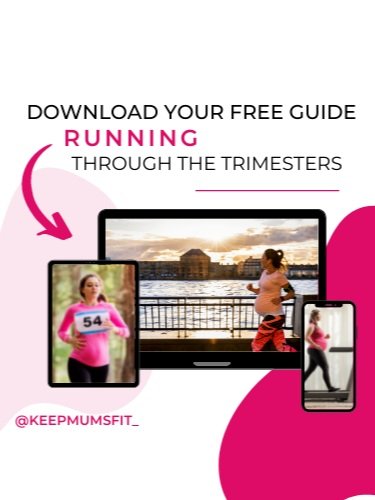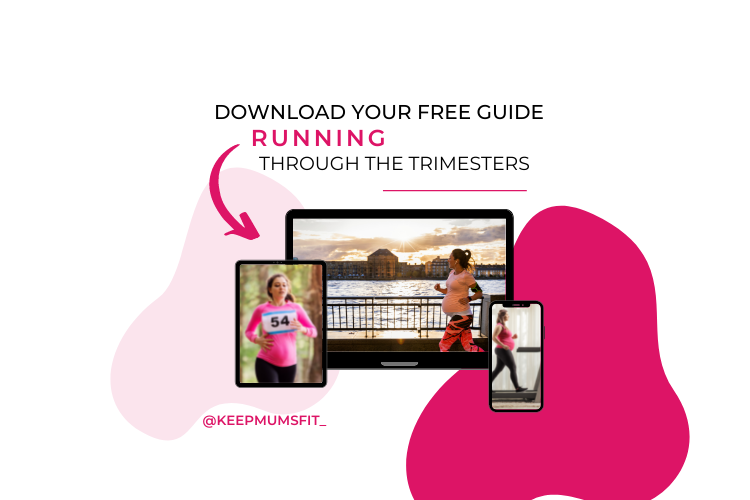Your FREE Guide to Running Through the Trimesters


Your FREE Guide to Running Through the Trimesters
An informative guide for those of you wishing to continue running throughout your pregnancy .
Pregnancy changes and adaptations, practical tips and guidance
First Trimester: 0-12 weeks
During the first month running feels much the same as normal. The body is only just beginning to change, and common symptoms can go unnoticed. Often the first thing a runner will notice is tiredness, a run may feel harder than normal, you may feel more out of breath and if you regularly monitor your time, you may notice your time is off by a few minutes. This is the body’s way of slowing you down so go with it!
Continue to run, as you would do normally listening to your body, slowing down when you need to and keep hydrated. However, one of the disadvantages of keeping well hydrated is the need to pass urine regularly so it may be a good idea to alter your route to one where toilets are easily available!
Running through the trimesters
Key points: Running through the trimesters
Physical activity during pregnancy is safe for women with uncomplicated pregnancies and should be actively encouraged by all health care professionals as part of a healthy lifestyle during pregnancy.
Recommendations are in line with those of the general population, with at least 30 minutes of moderate activity daily.
Regularly active women prior to pregnancy can continue to exercise until close to their due date but will naturally slow down as the pregnancy progresses.
The aim of continuing to exercise during pregnancy is to stay fit rather than to reach peak fitness.
There are many benefits to exercising during pregnancy and the common complaints, including fatigue, backache, varicose veins, swelling, stress, anxiety and depression are reduced in women who exercise.
Regular exercise may help prevent medical conditions such as gestational diabetes and high blood pressure.
Women who exercise regularly during pregnancy maintain a more positive body image and attitude towards themselves, their pregnancies, and their forthcoming labour and birth.
There is evidence to suggest that weight -bearing exercise can help exercising mums cope in labour needing less pain relief than women who don’t exercise.
Exercise helps improve the health of the baby by improving oxygen flow to the placenta, and allows the baby to tolerate labour better than those of non-exercisers.
There is no evidence to suggest that exercising regularly will result in miscarriage, premature rupture of membranes, premature labour or a low birth weight baby.
Endorsed by Dr Ferriman Consultant obstetrician at The Jessop wing Sheffield
Maintaining strength is important during pregnancy - come along to Keep Mums Fit Antenatal fitness and Skills for Birth class for expert coaching friendship and practical skills .
More information click here
Running throughout the seasons.
Body temperature can rise quite quickly in pregnancy and the concerns are if the core temperature rises there is potential risk to the growing baby. This is a concern particularly in the developing stages of pregnancy. Care must be taken to dress appropriately layering clothes and to always remain well hydrated.
Skin changes can occur darkening the skin in pregnancy so it’s advised to use sun protection to avoid harmful UV rays. Factor 30 when running in the sun can help protect the skin.
During the cooler months layering is a good idea. Wear a hat and gloves when running and care must be taken when it’s icy underfoot. If running alone take your phone and make sure someone knows the route you are running.
Running wear …. to Keep reading download your guide and let me know how you get on - I would love to hear
Head over to the Keep Mums fit page and post a picture - so many mums- to -be love inspiration and support
Kate x
Disclaimer Waiver and release of liability
COPYRIGHT © 2020 KATE CAMPBELL FITNESS ALL RIGHTS RESERVED
No part of this publication may be reproduced, transmitted or distributed in any form or by any means electronic or mechanical including photocopying, binding, recording or by any information storage and retrieval system, without expressed prior written permission from Kate Campbell.
The information presented herein is for educational purposes only and is in no way intended or implied to be a substitute for qualified professional medical advice. The information in this exercise guide and nutrition programme should be used in conjunction with the guidance and care of you the readers health care provider to determine the appropriateness of the information for your own situation. Consult your healthcare provider before beginning this programme as you would with any exercise and nutrition programme. If you choose not to obtain the consent of your health care provider throughout the duration of your time working with Kate Campbell fitness or her affiliates you are agreeing to accept full responsibility for your actions. By accepting your comprehensive nutrition and exercise programme you understand and recognise that despite all precautions on the part of Kate Campbell Fitness there are risks of injury or illness which can occur because of your use of the aforementioned information and you expressly assume such risks and waive relinquish and release any claim which you may have against Kate Campbell Fitness or her affiliates as a result of any future physical injury or illness incurred in connection with or as a result of the use or misuse of your programme.
